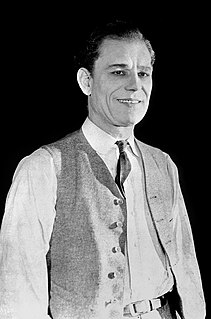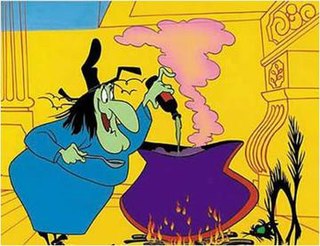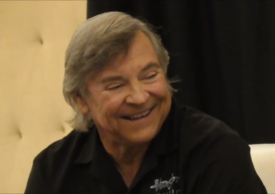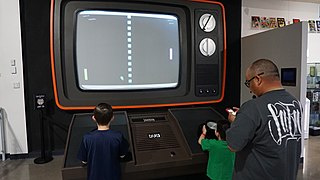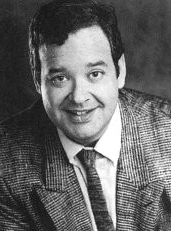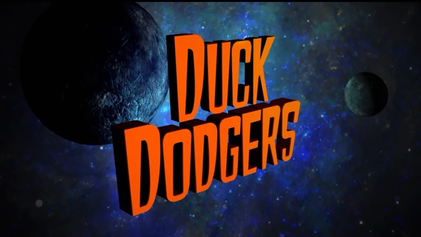
Melvin Jerome Blanc was an American voice actor and radio personality. After beginning his over-60-year career performing in radio, he became known for his work in animation as the voices of Bugs Bunny, Daffy Duck, Porky Pig, and most of the other characters from the Looney Tunes and Merrie Melodies theatrical cartoons during the golden age of American animation.

Porky Pig is an animated character in the Warner Bros. Looney Tunes and Merrie Melodies series of cartoons. He was the first character created by the studio to draw audiences based on his star power, and the animators created many critically acclaimed shorts featuring the character. Even after he was supplanted by later characters, Porky continued to be popular with moviegoers and, more importantly, the Warners directors, who recast him in numerous everyman and sidekick roles.

Tweety is an animated fictional yellow canary in the Warner Bros. Looney Tunes and Merrie Melodies series of animated cartoons. The name "Tweety" is a play on words, as it originally meant "sweetie", along with "tweet" being a typical English chick for the sounds of birds. His characteristics are based on Red Skelton's famous "Mean Widdle Kid." Tweety appeared in 46 cartoons during the golden age.
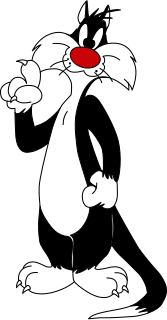
Sylvester J. Pussycat Sr., usually called Sylvester, is a fictional character, a three-time Academy Award-winning anthropomorphic Tuxedo cat in the Looney Tunes and Merrie Melodies series of cartoons. Most of his appearances have him often chasing Tweety, Speedy Gonzales, or Hippety Hopper. Sylvester appeared in 103 cartoons in the golden age of American animation, only behind Bugs Bunny, Porky Pig, and Daffy Duck. Three of his cartoons won Academy Awards, the most for any starring Looney Tunes character: they are Tweetie Pie, Speedy Gonzales, and Birds Anonymous.
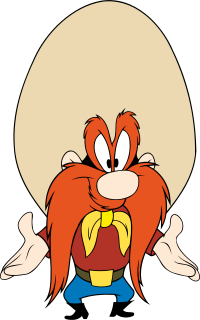
Yosemite Sam is an American animated cartoon character in the Looney Tunes and Merrie Melodies series of cartoons produced by Warner Bros. Animation. His name is taken from Yosemite National Park. Along with Elmer Fudd, he is an adversary of Bugs Bunny. He is commonly depicted as an extremely aggressive gunslinging prospector, outlaw, pirate, or cowboy with a hair-trigger temper and an intense hatred of rabbits, Bugs in particular. In cartoons with non-Western themes, he uses various aliases, including "Chilkoot Sam" and "Square-deal Sam" in 14 Carrot Rabbit, "Riff Raff Sam" in Sahara Hare, "Sam Schultz" in Big House Bunny, "Seagoin' Sam" in Buccaneer Bunny, "Shanghai Sam" in Mutiny on the Bunny, and "Von Schamm the Hessian" in Bunker Hill Bunny and many others. During the golden age of American animation, Yosemite Sam appeared in 33 shorts.
Rocky and Mugsy are animated cartoon characters in the Warner Bros. Looney Tunes and Merrie Melodies series of cartoons. They were created by Friz Freleng.
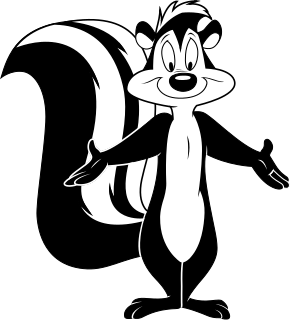
Pepé Le Pew is a character from the Warner Bros. Looney Tunes and Merrie Melodies series of cartoons, first introduced in 1945. Depicted as a French striped skunk, Pepé is constantly in search of love and appreciation. However, his offensive skunk odor and his aggressive pursuit of romance typically cause other characters to run from him.

Daffy Duck's Quackbusters is a 1988 Looney Tunes/Merrie Melodies film with a compilation of classic Warner Bros. Cartoons shorts and animated bridging sequences, starring Daffy Duck. It was the final theatrical production in which Mel Blanc provided the voices of the various Looney Tunes characters before his death on July 10, 1989. Unlike previous compilation films, Quackbusters uses pre-existing music from older Looney Tunes shorts composed by Carl Stalling, Milt Franklyn and William Lava for both the new animation and classic footage. It was also one of the two compilation films of classic Warner Bros. cartoon shorts not composed by Robert J. Walsh. The film was released to theaters by Warner Bros. on September 24, 1988. Similar to The Looney Looney Looney Bugs Bunny Movie, which was preceded with the Oscar-winning Knighty Knight Bugs (1958), Quackbusters is preceded with the exclusive short The Night of the Living Duck (1988).
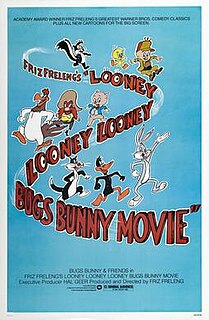
The Looney Looney Looney Bugs Bunny Movie is a 1981 American animated package film with a compilation of classic Looney Tunes/Merrie Melodies Warner Bros. cartoon shorts and animated bridging sequences produced by Friz Freleng, hosted by Bugs Bunny. The new footage was produced by Warner Bros. Animation and the first Looney Tunes/Merrie Melodies film with a compilation of classic shorts produced by Warner Bros. Animation.
Carrotblanca is a 1995 8-minute Looney Tunes cartoon. It was originally shown in theaters alongside The Amazing Panda Adventure and The Pebble and the Penguin (internationally). It was subsequently released on video packaged with older Looney Tunes cartoons and was included in the special edition DVD, and later HD DVD and Blu-ray, releases of Casablanca, the film to which it is both a parody and an homage. At the time of release, WB did not own the rights to Casablanca.
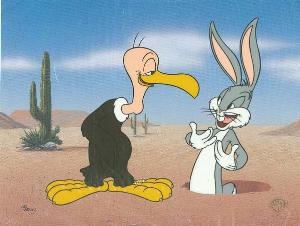
Beaky Buzzard is an animated cartoon character in the Warner Bros. Looney Tunes and Merrie Melodies series of cartoons.
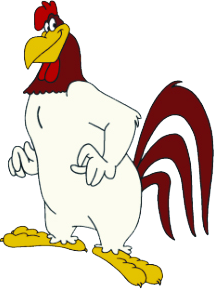
Foghorn Leghorn is a cartoon character that appears in Looney Tunes and Merrie Melodies cartoons and films from Warner Bros. Animation. He was created by Robert McKimson and writer Warren Foster, and starred in 29 cartoons from 1946 to 1964 in the Golden Age of American Animation. All 29 of these cartoons were directed by McKimson.

Elmer J. Fudd is a fictional cartoon character in the Warner Bros. Looney Tunes/Merrie Melodies series, and an adversary of Bugs Bunny. He has one of the more disputed origins in the Warner Bros. cartoon pantheon. His aim is to hunt Bugs, but he usually ends up seriously injuring himself and other antagonizing characters. He speaks in an unusual way, replacing his Rs and Ls with Ws, so he always refers to Bugs Bunny as a "scwewy wabbit". Elmer's signature catchphrase is, "Shhh. Be vewy vewy quiet, I'm hunting wabbits", as well as his trademark laughter.
Playboy Penguin is a character in the animated cartoon Looney Tunes, created by Chuck Jones in the late 1940s and early 1950s. He debuted in 1949's Frigid Hare and he re-appeared in 8 Ball Bunny.

The Looney Tunes Show is an American animated sitcom produced by Warner Bros. Animation that ran from May 3, 2011 through August 31, 2014 on Cartoon Network. The series consists of two seasons each containing 26 episodes, and features characters from the Looney Tunes and Merrie Melodies theatrical cartoon shorts updated for the 21st century.
Hugo the Abominable Snowman is a character in the Looney Tunes franchise.


